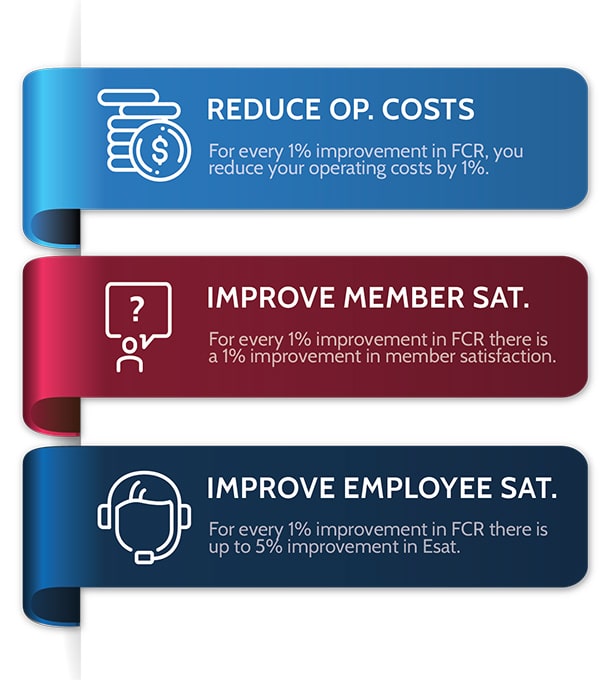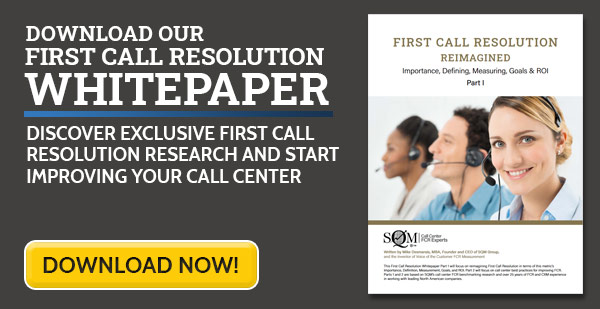What is a Good First Call Resolution Rate for Healthcare Call Centers?
At SQM, we benchmark the FCR rate with over 100 leading North American healthcare call centers annually and have been conducting FCR benchmarking studies for 25 years. Our Voice of the Customer (VoC) FCR benchmarking research is one of the most extensive research studies of healthcare FCR performance.
For our VoC FCR benchmarking studies, all call center participants must provide SQM a list of all calls they handled to ensure the customer surveying is a random sample of all calls their call centered handled. Making all calls eligible for a customer survey ensures that the FCR rate is accurate. This approach also allows us to benchmark the call center's FCR rate against their specific industry, the call center industry as a whole, and world class call centers.
SQM's research shows that when an organization uses external VoC FCR measurement methods (e.g., post-call survey, etc.), the call center healthcare industry average for FCR rate is 71%. This means that 29% of customers have to call back the organization about the same inquiry or problem. A good first call resolution rate for healthcare call centers is 70% to 75%.
Of the 100 leading North American healthcare call centers that SQM benchmarks, only 4% are at the world class VoC FCR performance level of 80% or higher. Achieving the world class standard of 80% or higher VoC FCR performance is the most popular FCR improvement goal that SQM healthcare call center clients strive to achieve and maintain.
Most healthcare call centers that consistently measure FCR using a post-call customer survey method improve their FCR rate. In fact, SQM's research shows that 70% of our healthcare call center clients who consistently measure their FCR, utilizing the post-call customer survey method improve year-over-year. The FCR gain by these healthcare call centers ranges from 1-20%. Healthcare call centers that implement VoC FCR measurement can expect an average FCR improvement of 3% or better, and in most cases, FCR improvement takes place within 90 days.
Importance of FCR to Healthcare Insurance Providers
The FCR metric has been around for over 25 years. We have learned a lot about the importance of this metric over those years. Initially, the only purpose of the FCR metric was to measure if the call was resolved on the first call. SQM's view is that it is much more than that, and the FCR metric should be viewed as a balanced scorecard metric because it measures service and cost and is the leading indicator for Csat, customer referrals, and retention. SQM's opinion is that the Voice of the Customer (VoC) FCR measurement method is the most accurate method for measuring FCR. VoC FCR measurement lets the customer judge whether FCR took place; after all, their opinion is what matters the most. A post-call customer survey should be used to allow the customer to be the judge of whether FCR took place.
When using VoC to measure FCR, a call center can expect an average ROI of 450% and a payback period of fewer than 3 months.
The Top 3 Reasons for Improving FCR in the Healthcare Industry
During this year's open enrollment period, do you know how you are going to reduce your call center costs while improving your member experience? FCR is the KING of all call center metrics because it measures your customer experience (CX) performance, is a key indicator of your operating cost efficiency, and provides you with insights into areas to improve. Here is why FCR improvement should matter to you as a healthcare insurance call center:
-
Reduce Operating Costs
For every 1% improvement in FCR, you reduce your operating costs by 1%.
With the focus on cost savings higher than ever, one of the most effective means to reducing costs is to reduce repeat calls. For the average healthcare insurance call center, a 1% improvement in FCR performance equals $286,000 in annual operational savings.
-
Improve Member Satisfaction
For every 1% improvement in FCR there is a 1% improvement in member satisfaction.
FCR is the metric with the highest correlation to member satisfaction. In fact, satisfaction drops 15% on average every time a member has to call back to get their call resolved. The pathway to improve member experience comes by first focusing on first call resolution.
-
Improve Employee Satisfaction
For every 1% improvement in FCR there is up to 5% improvement in Esat.
Healthcare insurance call centers with high FCR tend to have high Esat. Conversely, call centers with low FCR tend to have low Esat. The level of stress is much higher on the agent who has to handle a member's repeat call, so improving FCR can increase Esat substantially.

Quick Related Links
First Call Resolution Definition First Call Resolution PPT First Call Resolution BenefitsFirst Call Resolution Strategies First Call Resolution Operating Philosophy Helpdesk First Call ResolutionFirst Call Resolution Formula Calculate First Call Resolution Rate What is a Good FCR Rate?FCR Improvement Tips Agent CX Success Stories FCR Measurement Case Study


